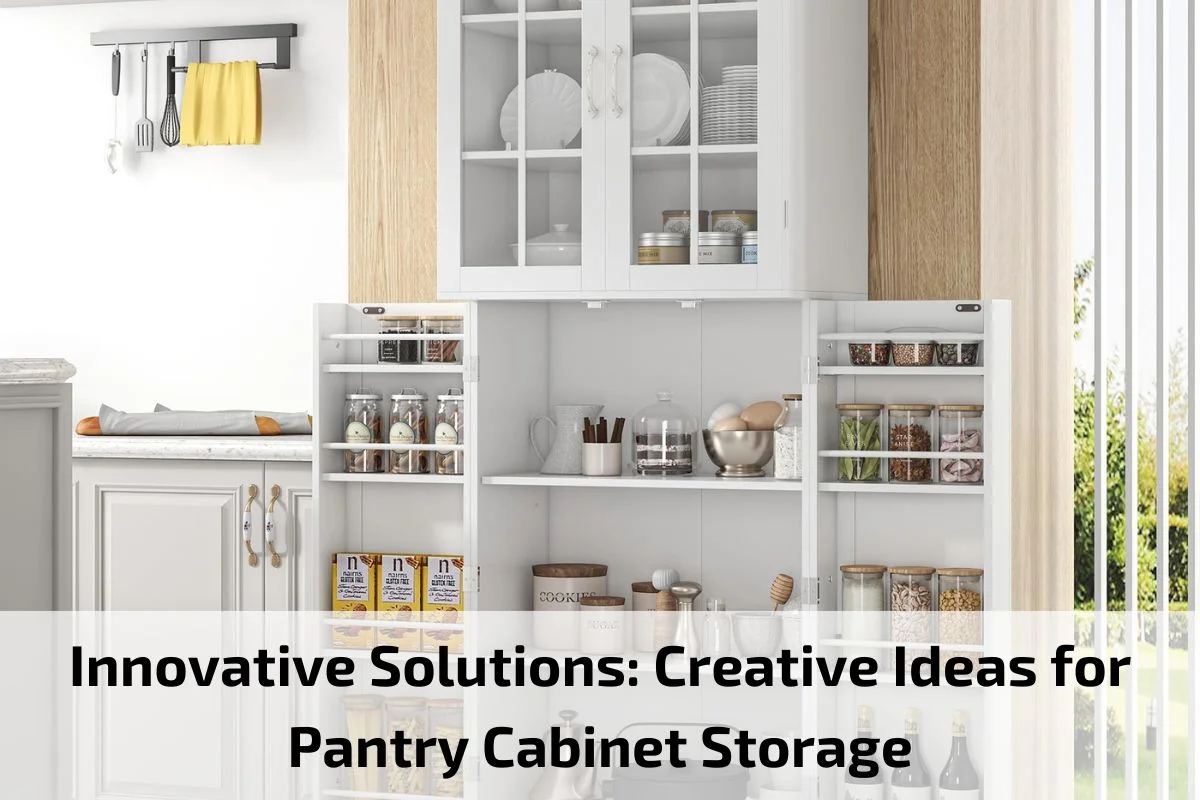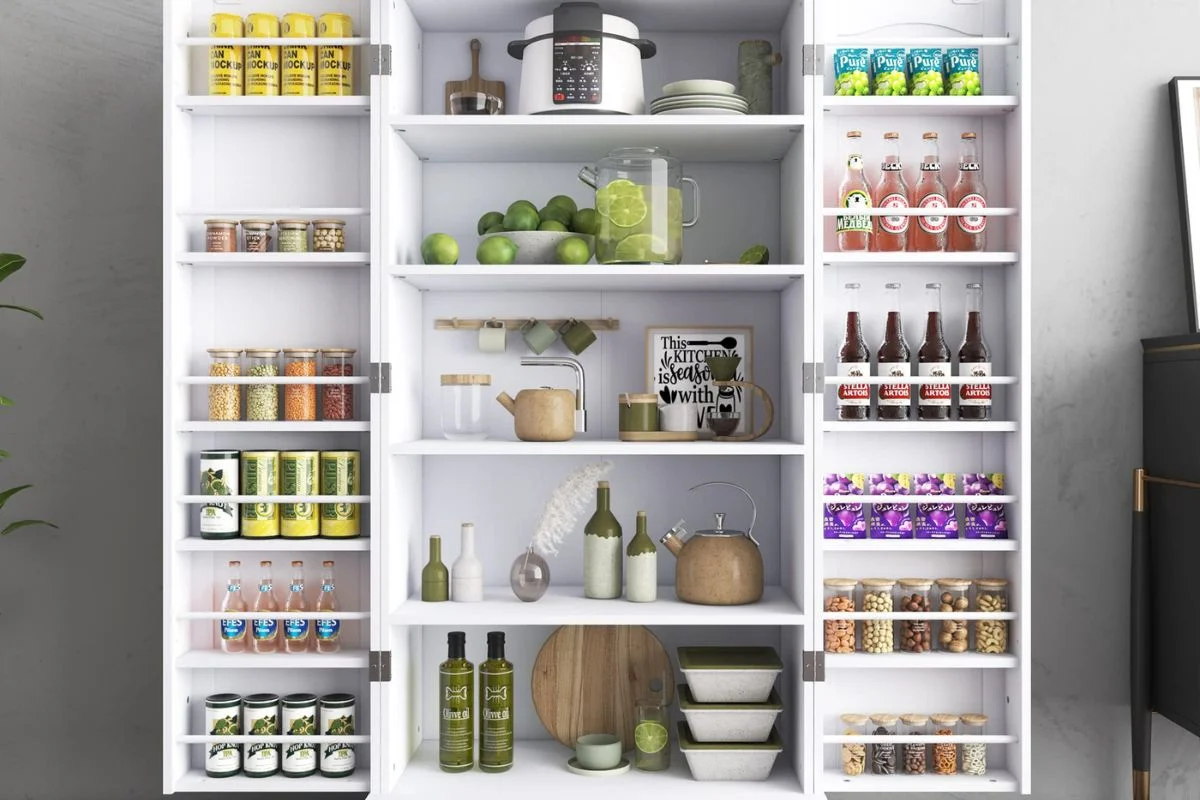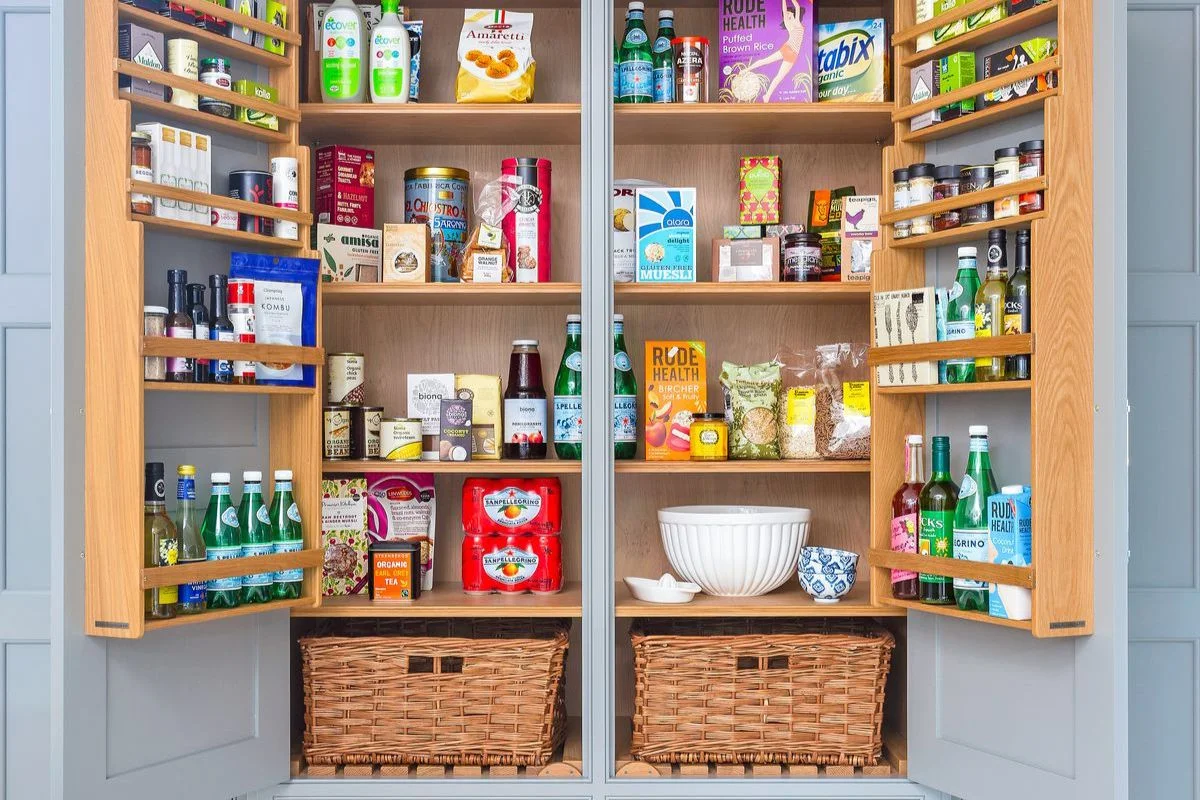Innovative Solutions: Creative Ideas for Pantry Cabinet Storage
In the realm of kitchen organization, the pantry cabinet stands as a beacon of storage efficiency and culinary convenience. Yet, beyond its traditional role of housing dry goods and canned items, the pantry cabinet offers a realm of creative possibilities for optimizing space and streamlining daily routines.
In this guide, we delve into the world of innovative solutions for pantry cabinet storage. Gone are the days of cluttered shelves and chaotic arrangements. Instead, we explore ingenious ideas and clever designs that maximize every inch of pantry space while elevating both functionality and aesthetics.
From customizable shelving systems to ingenious storage accessories, we uncover a myriad of creative solutions that transform pantry cabinets into organized sanctuaries for culinary essentials. Join us as we unlock the potential of pantry cabinet storage, offering inspiration and practical tips for creating a kitchen space that is as efficient as it is stylish.
Definition and Purpose of Pantry Cabinets
Pantry cabinets serve as dedicated storage spaces within a kitchen or adjacent area, specifically designed to store a wide range of food items, kitchen supplies, and household essentials. These cabinets are typically taller and deeper than standard kitchen cabinets, offering ample storage space for bulk food items, canned goods, small appliances, and other pantry staples.
The primary purpose of pantry cabinets is to provide organized storage solutions that help homeowners optimize their kitchen space and streamline meal preparation and cooking processes. By centralizing food storage and kitchen essentials in one designated area, pantry cabinets enhance convenience, accessibility, and efficiency in the kitchen.
Pantry cabinets play a crucial role in kitchen organization by:
Maximizing Storage: Pantry cabinets offer generous storage capacity, allowing homeowners to store a large quantity of food items and kitchen supplies in a single location.
Promoting Organization: With adjustable shelves, drawers, and specialized storage accessories, pantry cabinets facilitate efficient organization of pantry items, making it easy to locate and access specific items when needed.
Enhancing Accessibility: Pantry cabinets are designed to optimize accessibility, ensuring that essential items are within reach and easily visible, thus minimizing the time and effort required to retrieve ingredients during meal preparation.
Supporting Meal Planning: By providing a designated space for storing pantry staples, pantry cabinets enable homeowners to inventory food items, plan meals, and reduce waste by ensuring that ingredients are used before they expire.
Improving Kitchen Aesthetics: Beyond their functional benefits, pantry cabinets contribute to the overall aesthetics of the kitchen, enhancing its visual appeal and creating a cohesive and organized environment that reflects the homeowner’s personal style.
Importance of Pantry Cabinets in Kitchen Organization
Pantry cabinets serve as the backbone of efficient kitchen organization, offering a dedicated space to store a wide array of food items, cooking essentials, and kitchen supplies. Their importance in the overall functionality and organization of a kitchen cannot be overstated. Here are several reasons why pantry cabinets are indispensable for kitchen organization:
Maximizing Storage Space: Pantry cabinets provide ample storage space, allowing homeowners to stockpile pantry staples, bulk goods, and kitchen essentials in one centralized location. By utilizing the vertical space and depth of pantry cabinets, homeowners can maximize storage capacity and keep their kitchen clutter-free.
Promoting Organization: With adjustable shelves, pull-out drawers, and specialized storage accessories, pantry cabinets facilitate efficient organization of pantry items. Items can be categorized, labeled, and arranged systematically, making it easy to locate ingredients and supplies during meal preparation.
Enhancing Accessibility: Pantry cabinets are designed to optimize accessibility, ensuring that essential items are within reach and easily visible. This accessibility minimizes the time and effort required to retrieve ingredients, allowing for smoother and more efficient meal preparation and cooking processes.
Facilitating Meal Planning: A well-organized pantry cabinet enables homeowners to inventory food items, plan meals, and track inventory levels effectively. With ingredients readily available and easily visible, homeowners can plan meals more efficiently, reducing food waste and saving time on grocery runs.
Streamlining Cooking Processes: By keeping commonly used ingredients and cooking utensils within arm’s reach, pantry cabinets streamline cooking processes and enhance kitchen efficiency. Homeowners can access ingredients quickly and seamlessly while preparing meals, leading to smoother cooking experiences and better culinary outcomes.
Creating a Clutter-Free Environment: Pantry cabinets help maintain a clutter-free kitchen environment by providing designated storage space for pantry items. By keeping countertops and other kitchen surfaces clear of clutter, pantry cabinets contribute to a more organized and visually appealing kitchen space.
Increasing Home Value: Well-designed pantry cabinets are considered desirable features in modern kitchens and can enhance the overall value and marketability of a home. Homebuyers often prioritize kitchens with ample storage space and organized pantry cabinets, making them attractive selling points for prospective buyer
Benefits of Incorporating Pantry Cabinets into Kitchen Design
Incorporating pantry cabinets into kitchen design offers numerous benefits that contribute to the functionality, organization, and aesthetics of the space. Here are several key advantages of integrating pantry cabinets into kitchen design:
Maximized Storage Space: Pantry cabinets provide dedicated storage space for pantry items, allowing homeowners to stockpile food staples, cooking essentials, and kitchen supplies in one centralized location. By utilizing vertical space and deep shelving, pantry cabinets maximize storage capacity and help keep the kitchen organized and clutter-free.
Efficient Organization: With adjustable shelves, pull-out drawers, and specialized storage accessories, pantry cabinets facilitate efficient organization of pantry items. Ingredients can be categorized, labeled, and arranged systematically, making it easy to locate items and streamline meal preparation and cooking processes.
Improved Accessibility: Pantry cabinets optimize accessibility, ensuring that essential items are within reach and easily visible. This accessibility minimizes the time and effort required to retrieve ingredients, enhancing efficiency and convenience during meal preparation and cooking.
Enhanced Meal Planning: A well-organized pantry cabinet enables homeowners to inventory food items, plan meals, and track inventory levels effectively. With ingredients readily available and easily visible, homeowners can plan meals more efficiently, reduce food waste, and save time on grocery runs.
Streamlined Cooking Processes: By keeping commonly used ingredients and cooking utensils within arm’s reach, pantry cabinets streamline cooking processes and enhance kitchen efficiency. Homeowners can access ingredients quickly and seamlessly while preparing meals, leading to smoother cooking experiences and better culinary outcomes.
Clean and Clutter-Free Environment: Pantry cabinets help maintain a clean and clutter-free kitchen environment by providing designated storage space for pantry items. By keeping countertops and other kitchen surfaces clear of clutter, pantry cabinets contribute to a more organized and visually appealing kitchen space.
Customizable Design Options: Pantry cabinets come in a variety of styles, sizes, and configurations, allowing homeowners to customize their design to suit their specific needs and preferences. Whether opting for built-in floor-to-ceiling cabinets or freestanding pantry units, homeowners can choose a design that complements their kitchen layout and enhances its overall aesthetic appeal.
Increased Home Value: Well-designed pantry cabinets are considered desirable features in modern kitchens and can enhance the overall value and marketability of a home. Homebuyers often prioritize kitchens with ample storage space and organized pantry cabinets, making them attractive selling points for prospective buyers.
In summary, incorporating pantry cabinets into kitchen design offers numerous benefits, including maximized storage space, efficient organization, improved accessibility, streamlined cooking processes, and enhanced aesthetics. Pantry cabinets play a crucial role in creating functional, organized, and visually appealing kitchen spaces that meet the needs of homeowners and add value to their homes.
Stylish Pantry Cabinet Designs and Finishes
Pantry cabinets not only offer functional storage solutions but also contribute to the overall aesthetic appeal of the kitchen. Here, we explore various stylish pantry cabinet designs and finishes that can elevate the look of your kitchen:
- Traditional Elegance: Traditional pantry cabinet designs often feature raised panel doors, decorative moldings, and ornate hardware. Choose finishes like rich wood tones such as cherry or mahogany for a classic, timeless look that exudes elegance and sophistication.
- Contemporary Chic: Contemporary pantry cabinets boast sleek lines, minimalist designs, and modern finishes. Opt for flat-panel doors, clean edges, and brushed metal hardware for a sleek and sophisticated aesthetic. Consider finishes like glossy white or matte black for a stylish, contemporary look that complements modern kitchen decor.
- Rustic Charm: Rustic pantry cabinets add warmth and character to the kitchen with their distressed finishes, natural wood grains, and charming details. Look for reclaimed wood or distressed finishes in warm, earthy tones like weathered gray or barnwood for a cozy, inviting look that brings a touch of rustic charm to the kitchen.
- Transitional Appeal: Transitional pantry cabinets blend traditional and contemporary elements to create a versatile and timeless look. Mix and match finishes and hardware to create visual interest, and choose door styles like shaker or beadboard for a classic yet modern appeal that bridges the gap between traditional and contemporary design.
- Customized Solutions: Custom pantry cabinets offer endless design possibilities, allowing you to tailor the cabinets to your specific needs and preferences. Choose custom features like built-in wine racks, pull-out spice racks, and adjustable shelving to create a personalized storage solution that maximizes functionality and complements your kitchen design.
- Integrated Appliances: Consider integrating appliances like refrigerators, freezers, or microwaves into your pantry cabinet design for a seamless and streamlined look. Appliance panels can be customized to match the cabinetry, creating a cohesive and integrated appearance that enhances the overall aesthetic of the kitchen.
- Glass Fronts: Glass-front pantry cabinets add a touch of elegance and sophistication to the kitchen by showcasing decorative items or pantry essentials behind transparent glass doors. Choose frosted or seeded glass for a subtle, obscured look, or opt for clear glass to put your favorite dishes or collections on display.
- Two-Tone Finishes: Experiment with two-tone finishes to add visual interest and depth to your pantry cabinet design. Pair light and dark finishes or mix contrasting colors for a modern, eclectic look that adds personality and character to the kitchen.
Tips for Maintaining and Organizing Pantry Cabinets
Maintaining and organizing pantry cabinets is essential for ensuring their longevity and maximizing their functionality. Here are some helpful tips to keep your pantry cabinets organized and well-maintained:
Declutter Regularly: Periodically go through your pantry cabinets and declutter items that are expired, unused, or no longer needed. Dispose of expired food items, donate non-perishable items you won’t use, and recycle or discard packaging to keep your pantry clutter-free.
Categorize Items: Group similar items together and categorize them logically to make it easier to find what you need. Consider organizing items by type (e.g., canned goods, grains, baking supplies) or frequency of use (e.g., daily essentials, occasional treats) for efficient storage and retrieval.
Utilize Storage Solutions: Invest in storage accessories such as stackable bins, wire baskets, lazy Susans, and shelf risers to maximize space and keep pantry items organized. Use clear containers or labeled bins to store loose items like snacks, grains, and spices for easy identification.
Adjust Shelf Heights: Customize shelf heights to accommodate items of different sizes and shapes. Adjust shelves as needed to create additional space for tall items like cereal boxes or bulky kitchen appliances, ensuring efficient use of vertical space in your pantry cabinets.
Rotate Stock: Practice the “first in, first out” (FIFO) method to rotate stock and prevent food waste. Place newly purchased items behind older ones to ensure that older items are used before they expire, minimizing waste and keeping your pantry stocked with fresh ingredients.
Maintain Cleanliness: Regularly clean and wipe down pantry shelves, drawers, and surfaces to remove dust, spills, and debris. Use a mild detergent or vinegar solution and a damp cloth to clean shelves and surfaces, and vacuum or sweep the floor to keep your pantry cabinets clean and sanitary.
Check for Pest Control: Inspect pantry cabinets periodically for signs of pests such as insects or rodents. Seal any cracks or openings, store food items in airtight containers, and use pest deterrents like traps or repellents to prevent infestations and protect your pantry items.
Monitor Expiration Dates: Keep track of expiration dates on food items and pantry staples to ensure that you use them before they expire. Regularly check expiration dates and rotate stock accordingly to maintain a fresh and well-stocked pantry.
Conclusion
Incorporating pantry cabinets into your kitchen design is a strategic investment that pays dividends in terms of organization, efficiency, and convenience. From maximizing storage space to enhancing accessibility and streamlining cooking processes, pantry cabinets play a vital role in creating a functional and organized kitchen environment.





0 comments